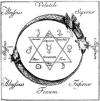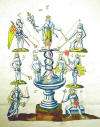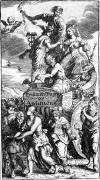The Seven Metals
Usually the great Work is divided in three
stages according to the three principles colors: black for Nigredo,
white for Albedo, and red for Rubedo. But there is another system that
divides the Great Work alongside this threefold system, and that is the
one of the seven metals or planets which must be interpreted according
Greek mythology.
Nothing is so confusing as the seven metals in
alchemy. In some manuscripts the name of metals is used alongside other
symbols. Sometimes the metals are described a bit more in detail. often
it is difficult to figure out if it is about laboratory work or purely
symbolic.
In Dictionnaire mytho-hermétique Dom Pernety (an 18th
century French writer, Benedictine, librarian, and founder of a secret
society) defines the use of the seven metals in hermetic alchemy as
follows: "When the Wise talk about metals, they do not understand these
objects that are in use in everyday life; one must understand them in
the sense of that they talk about the transmutation of imperfect metals
in gold or silver. Their metals are only different states of their
mercury in the operation of the work. These states are seven in number,
like there are seven Planets and seven common metals; this is the reason
why they give the system of their work to the seven Planets, which rule
at every state, and every dominion manifest itself by a different color.
The first state is that of mercury, which comes before the black color.
The second is that of Saturn that lasts all through putrefaction until
the matter start to become gray, that is when the Wise call their matter
lead of the Philosophers. The third is that of Jupiter, son of Saturn,
who was subject to his voracious father, who mutilated him in order to
prevent the ability to procreate: his mutilates parts were thrown in the
ocean and they gave birth to Venus, by which one understands that the
black color does not appear anymore in the work. And because Jupiter was
the father of the gods, with Junon, represented by the air enclosed in
the vase, and the humidity which mixes itself with it.
"The entire
dominion of Jupiter is used to wash the milk, what happens by the
successive ascending and descending of mercury on the earth. That water
represents the sea, Of which the flow and reflux is marked by these
ascensions and continual descensions. But the Philosophers have another
sea, that one will see explained in his item.
"The Poets gave to this
milk the name of Latone, mother of the Moon and Sun; because the moon
period is a continuation of the ablution of the milk, that by there
becomes white, and of a whiteness bursting as the one of the Moon. Venus
dominates next, and this is in the time that the matter takes a citrine
color, that goes over to red, or of iron rust color, and thus comes the
period of Mars, friend of Venus, that lasts until the color orange,
represented by the dawn, before sun comes up. Phoebus, brother of Diane,
appears at last under the crimson color. The Poets said that Diane his
sister played the role of midwife to his mother Latone when she gave
birth to the sun, because real gold, or real sun of the Philosophers,
would never appear until the white color, or Diane, had not appeared
beforehand. By all this one can easily see how many Mythological
hermetici are mistaken in their arbitrary explanations of the Fables, as
this is only a allegory applied to the Great Work".
This might be a
bit difficult to read and understand if you are a novice to alchemy.
After all, you are supposed to be knowledgeable about the different
Greek mythological tales. The hermetici in past ages were familiar with
Greek mythology because it was their prime source for understanding the
human condition and their world view. They understood that the myths
were symbolic and allegoric.
In a nutshell:
1. Mercury, planet
Mercury: the substance, the Matter to be worked on. originally you have
to find out what it is. For the Hermetic Alchemists it is of course you
yourself, what includes your body, your mind (=emotions and thoughts)
and your divine essence.
2. Lead, planet Saturn: the beginning of the
state of Blackness. The Matter is putrefying and dissolving.
3. Tin,
planet Jupiter: the color gray that appears at the end of the process of
Blackness, when the Matter has been purified to almost a perfect white.
Jupiter is the son of Saturn, therefore he is the next stage.
4.
Copper, planet Venus: the citrine color. Venus is the next stage because
she was born when the testicles of Jupiter, cut off by his father
Saturn, fell into the sea.
5. Silver, the Moon: the white color,
corresponding to the state of Whiteness or Albedo. The Matter has been
completely purified. In Greek mythology the Moon is symbolized by the
huntress goddess Diane. Diane is the daughter of Jupiter and Latone.
6. Iron, planet Mars: Mars is the friend and lover of Venus. Orange or
rust-red color, like the light of dawn. It is the state during which the
Matter starts to become red.
7. Gold, the Sun: this is the last
state; the red color or Rubedo. Here the Matter is called Red Sulfur,
among other terms. The sun god Apollo.
As the Hermetic Philosophers
were well versed in ancient mythology and derived a lot of their
symbolism from it, it might be interesting to note that the use of the
seven planets as a progression in the Great Work has a stunning parallel
in Gnostic teachings. The Gnostics explained that man here on Earth
lives basically in a spiritual darkness. Through initiation he ascends
through seven layers/worlds created by the Archonts to eventually arrive
at the eight sphere where the initiate will shine in all its divine
glory. The seven spheres were associated with the seven traditional
planets, and they were each a hindrance to the progress of the spiritual
person. It is remarkable that the alchemists also talked about passing
through seven stages of the Great Work, each associated with one of the
seven planets.
The seven metal/planets in images:
 |
 |
 |
 |
 |